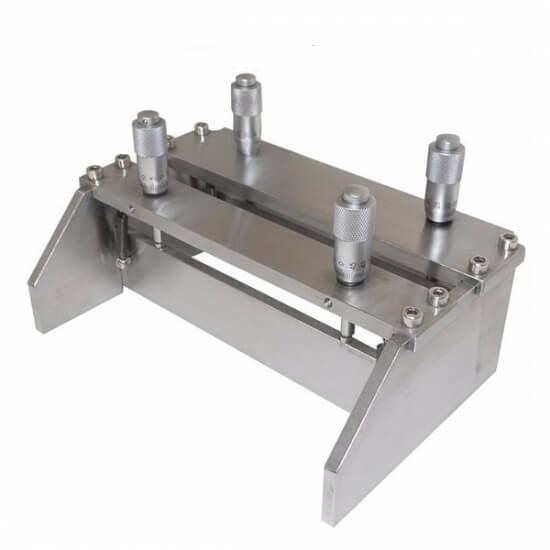Bar Coater: A Key Tool in Precision Coating Applications
A Bar Coater is a specialized tool or machine used to apply uniform coatings onto flat surfaces, such as substrates, films, or sheets. It plays a crucial role in industries where precise and consistent coating thickness is essential, including electronics, automotive, aerospace, and manufacturing. In this blog post, we’ll explore what a Film Coating Machine is, how it works, its applications, advantages, and why it’s indispensable in modern coating processes.
---
●What Is a Bar Coater?
A bar coater is a device that uses a metal or ceramic bar with grooves or patterns on its surface to apply a controlled layer of liquid material (such as ink, paint, adhesive, or other coatings) onto a substrate. The grooves or patterns on the bar determine the thickness and texture of the applied coating, ensuring consistency across the entire surface.
The key components of a bar coater include:
- Coating Bar: The main element, which can be smooth or patterned, depending on the desired coating effect.
- Substrate Holder: A platform or conveyor system that supports the material being coated.
- Reservoir: A container for holding the coating material before application.
---
●How Does a Bar Coater Work?
The process of using a bar coater involves the following steps:
1. Preparation:
- The substrate is placed on the holder or conveyor.
- The coating material is poured into the reservoir or directly onto the substrate.
2. Application:
- The coating bar is drawn across the substrate either manually or mechanically.
- As the bar moves, it meters the coating material onto the surface, leaving behind a uniform layer.
3. Drying/Curing:
- After application, the coated substrate may undergo drying or curing processes to solidify the coating.
---
●Types of Bar Coaters
Bar coaters come in various designs to suit different applications:
1. Smooth Bar Coaters:
- Use a plain, ungrooved bar to apply thin, even layers of coating.
- Ideal for applications requiring minimal texture.
2. Patterned Bar Coaters:
- Feature bars with specific grooves or patterns to create textured coatings.
- Used in decorative or functional coatings, such as embossing effects.
3. Manual vs. Automated Bar Coaters:
- Manual bar coaters are operated by hand and are suitable for small-scale or laboratory settings.
- Automated bar coaters integrate with production lines for high-volume manufacturing.
---
●Applications of Bar Coaters
Bar coaters are widely used across industries due to their precision and versatility. Some common applications include:
1. Electronics Manufacturing
- Applying conductive inks or adhesives onto circuit boards.
- Coating protective layers on electronic components.
2. Automotive Industry
- Applying primer or paint coatings on vehicle parts.
- Creating textured finishes for interior components.
3. Packaging
- Applying adhesive or sealant coatings on packaging materials.
- Adding decorative effects to labels or wrappers.
4. Printing and Publishing
- Coating paper or film with varnishes or UV-resistant layers.
- Applying ink layers in multi-step printing processes.
5. Medical Devices
- Coating medical implants or tools with biocompatible materials.
- Applying lubricants or antimicrobial agents to devices.
---
●Advantages of Using a Bar Coater
1. Precision Control:
- Ensures consistent coating thickness, reducing waste and improving product quality.
2. Versatility:
- Can handle a wide range of materials, from liquids and pastes to viscous substances.
3. Cost-Effectiveness:
- Reduces material usage compared to spray or dip coating methods.
4. Ease of Use:
- Simple operation, whether manual or automated, makes it accessible for both lab and industrial settings.
5. Customization:
- Different bar patterns allow for tailored coatings based on specific application needs.
---
●Challenges in Using Bar Coaters
While bar coaters offer numerous benefits, there are some challenges to consider:
1. Material Compatibility:
- Certain coating materials may not adhere well to specific substrates, requiring pre-treatment or additives.
2. Maintenance:
- Bars and equipment must be cleaned regularly to prevent contamination and ensure consistent performance.
3. Thickness Limitations:
- Bar coaters are best suited for thin coatings; thicker layers may require alternative methods.
4. Surface Preparation:
- Substrates must be clean and free of defects to achieve optimal coating results.
---
●Innovations in Bar Coating Technology
Advancements in technology continue to enhance the capabilities of bar coaters:
1. Smart Coating Systems:
- Integration of sensors and automation for real-time monitoring and adjustment of coating parameters.
2. Advanced Materials:
- Development of new coating materials optimized for specific applications, such as self-healing or anti-corrosion coatings.
3. Sustainable Practices:
- Focus on eco-friendly coatings and reduced solvent use to minimize environmental impact.
4. Hybrid Techniques:
- Combining bar coating with other methods, such as roll-to-roll processing, for increased efficiency and flexibility.
---
●The Future of Bar Coaters
As industries increasingly demand higher precision, faster throughput, and more sustainable practices, bar coaters will continue to evolve. Innovations in materials science, automation, and digital technologies will enable even greater control over coating processes, opening up new possibilities in fields like renewable energy, healthcare, and advanced manufacturing.
Looking ahead, bar coaters will play an increasingly important role in shaping the future of precision coating applications, driving innovation and efficiency across multiple sectors.
---
●Conclusion
Bar coaters are essential tools for achieving uniform and precise coatings in a variety of industries. Their ability to deliver consistent results, combined with their versatility and cost-effectiveness, makes them indispensable in modern manufacturing and research environments.
What excites you most about the potential of bar coaters? Share your thoughts in the comments below! Together, let’s explore how advancements in coating technology can shape a brighter, more innovative future.





 Online service
Online service +86 13174506016
+86 13174506016
